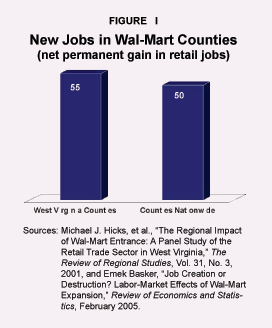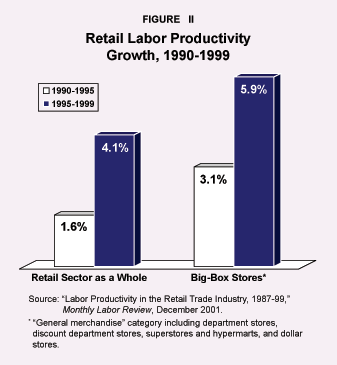Neighborhoods, city councils and the media are debating whether to welcome or discourage big-box retailers. While Wal-Mart comes to mind, big-box retailers are defined as any free-standing store greater than 50,000 square feet, and most big-box stores now range in size from 90,000 to 200,000 square feet. Critics claim that large retailers crowd out mom-and-pop competitors and replace them with windowless warehouses filled with minimum wage workers. Big-box retailers promise economic benefits such as sales tax revenues, jobs, competitive wages and low prices. But do they deliver? Empirical evidence shows that they have provided numerous benefits.

The Development of Big-Box Stores. Over the past 50 years, increasing mobility has made it possible for people to shop greater distances from where they live or work. The increased competition for customers necessitated larger stores. David Boyd of Denison University argues that changing regulations also facilitated the spread of large retailers. Until the federal Consumer Goods Pricing Act of 1975, manufacturers could establish minimum prices at which their products must be sold by retailers. Such resale price maintenance severely limited price competition. The current law, however, allows mass merchandisers to provide manufacturers' products at a lower price.
Big-Box Benefit: Increased Local Sales. Kenneth Stone of Iowa State University found that retail sales dollars from adjacent counties are lost to counties with big-box stores. In a study on the impact of Menards home improvement stores on Iowa counties, Stone concluded:
- Counties with Menards stores averaged about $21 million more in sales six years after the store opened compared to adjacent counties.
- Adjacent counties lost about $5 million in sales, on the average, indicating that consumers were crossing county lines to shop at Menards.
Stone also found the effect of Wal-Mart supercenters in Mississippi was similar. Furthermore, he discovered that some stores not in direct competition with Wal-Mart, such as high-end furniture stores, experienced greater sales due to the increase in shoppers attracted to the nearby Wal-Mart.
Big-Box Benefit: More Jobs. Critics assume that the greater competitive edge of big-box retailers comes from their ability to hire fewer workers and pay them less. However, empirical evidence has not found this to be true.
- Marshall University professor Michael Hicks found that West Virginia counties with Wal-Mart stores experienced a permanent net gain of about 55 retail jobs, on the average.
- A University of Missouri study of 1,749 counties nationwide showed that Wal-Mart counties experienced a permanent net gain of 50 retail jobs. (See Figure I.)
- Bates College researchers Brian Ketchum and James Hughes showed that Wal-Mart host counties in Maine experienced a net gain in weekly retail wages of $8.24 relative to non-Wal-Mart counties. While this is not statistically significant, it confirms that Wal-Mart did not lower retail wages.
The West Virginia study also revealed that Wal-Mart host counties experienced an average net increase of five new retail firms. Researchers refer to this as the "travel substitution effect": shoppers who previously drove to larger urban areas now have the incentive to shop in their own town, prompting new firms to cluster around big boxes.
Big-Box Benefit: Increased Productivity. Nationwide, big-box retailers have increased labor productivity, as measured by retail sales per employee:

- Between 1990 and 1999, much of the productivity growth in general merchandise stores was attributed to larger stores and greater use of "point of sale" technology, such as scanners. (See Figure II.)
- From 1995 to 1999, labor productivity grew 2.3 percent annually, compared to only 1 percent annually between 1987 and 1995.
- One quarter of the 1.3 percentage point increase in productivity came from the retail sector, and one-sixth of this was mainly due to Wal-Mart.
Since Wal-Mart began the push toward efficient distribution, other stores have copied its practices. Big-box retailers have an efficiency advantage: larger stores can house a greater selection of goods, encouraging more purchases by consumers and more sales per square foot, which enables them to reap economies of scale.
Big-Box Benefit: Lower Prices. Although big-box stores create a highly competitive environment that can crowd out smaller stores, they also reduce prices. Analyzing 102 urban, suburban and rural areas nationwide (with and without Wal-Mart supercenters), a study from the University of Texas at Dallas recently found the presence of a supercenter was associated with a 1.36 point decline in the Consumer Price Index (CPI) for groceries, even when controlling for local differences in the cost-of-living.
Moreover, a recent study from the National Bureau of Economic Research reveals the CPI does not completely reflect price changes when big-box stores such as Wal-Mart replace other stores. In other words, if a new Wal-Mart replaces a competitor, the Bureau of Labor Statistics survey is not adjusted to reflect the lower prices of the new store. This phenomenon is known as "consumer substitution bias" in the CPI. It results in an overstatement of the grocery inflation rate by about 15 percent annually.
The evidence that big-box retailers bring lower prices is not surprising. The cost of re-stocking goods is lower in large stores that use advanced technology, such as optical scanners, in their distribution systems. They pass these cost savings on to consumers.
Conclusion. Undoubtedly, as retail evolves and reduces market inefficiencies, small retailers will be affected. But evolving industries are nothing new; transportation, health care and other industries look far different than they did even a few decades ago. The efficiencies and market benefits brought by big box retailers should not be ignored in community debate.
Pamela Villarreal is a research associate with the National Center for Policy Analysis.